HLT100 Case Study: Integrative Analysis of Anatomy & Physiology
VerifiedAdded on 2022/10/15
|9
|2526
|12
Case Study
AI Summary
This healthcare case study comprehensively analyzes various aspects of anatomy and physiology in the context of a patient scenario. It covers topics such as skin structure and thermoregulation in newborns, gestational diabetes and its management through exercise and nutrition, bone healing challenges during pregnancy, and complications related to hyperemesis gravidarum (HG), including electrolyte imbalances and nutritional deficiencies. The study also references various research articles to support its analysis and recommendations. Desklib offers a wide range of similar solved assignments and past papers for students.
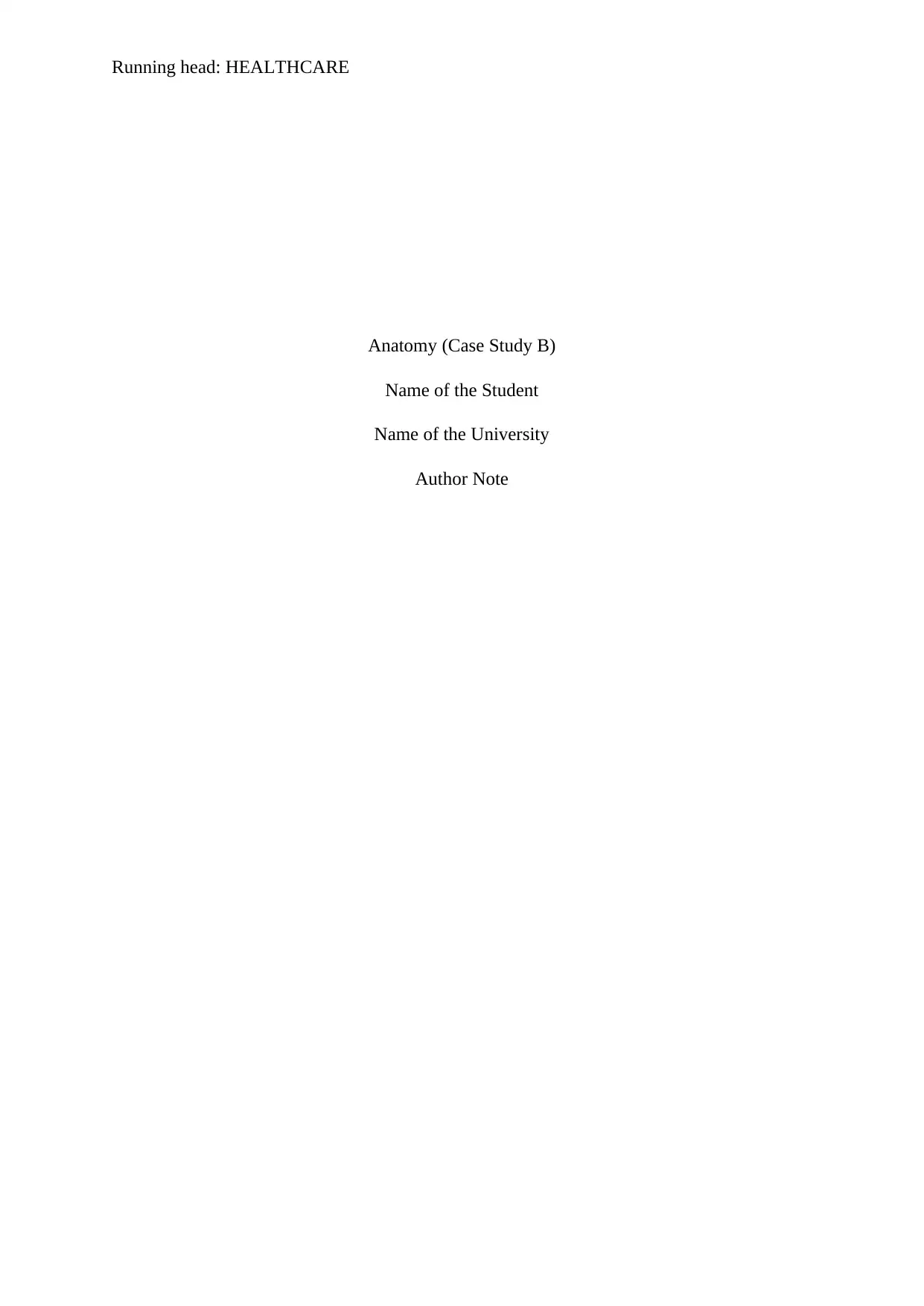
Running head: HEALTHCARE
Anatomy (Case Study B)
Name of the Student
Name of the University
Author Note
Anatomy (Case Study B)
Name of the Student
Name of the University
Author Note
Paraphrase This Document
Need a fresh take? Get an instant paraphrase of this document with our AI Paraphraser
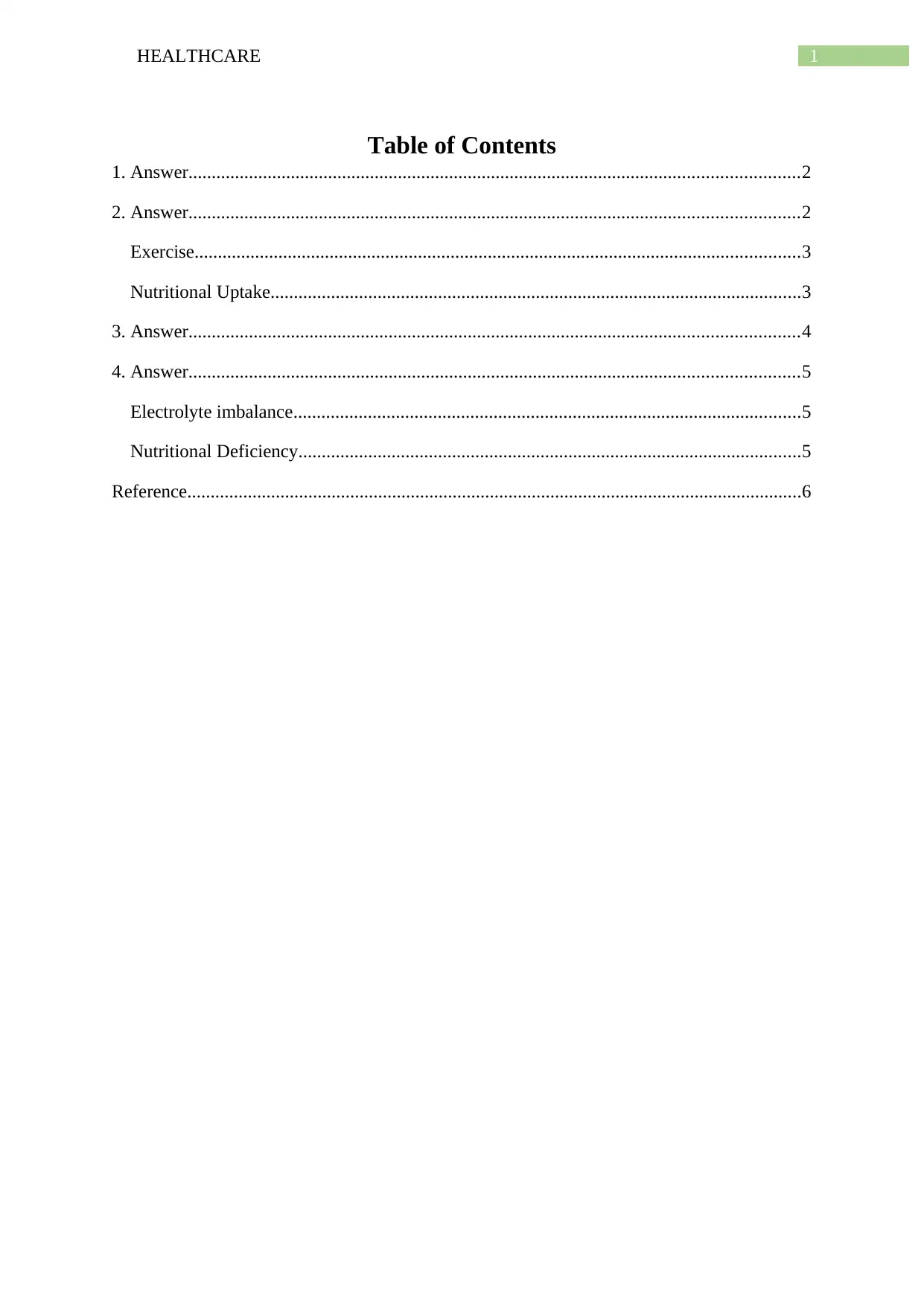
1HEALTHCARE
Table of Contents
1. Answer...................................................................................................................................2
2. Answer...................................................................................................................................2
Exercise..................................................................................................................................3
Nutritional Uptake..................................................................................................................3
3. Answer...................................................................................................................................4
4. Answer...................................................................................................................................5
Electrolyte imbalance.............................................................................................................5
Nutritional Deficiency............................................................................................................5
Reference....................................................................................................................................6
Table of Contents
1. Answer...................................................................................................................................2
2. Answer...................................................................................................................................2
Exercise..................................................................................................................................3
Nutritional Uptake..................................................................................................................3
3. Answer...................................................................................................................................4
4. Answer...................................................................................................................................5
Electrolyte imbalance.............................................................................................................5
Nutritional Deficiency............................................................................................................5
Reference....................................................................................................................................6
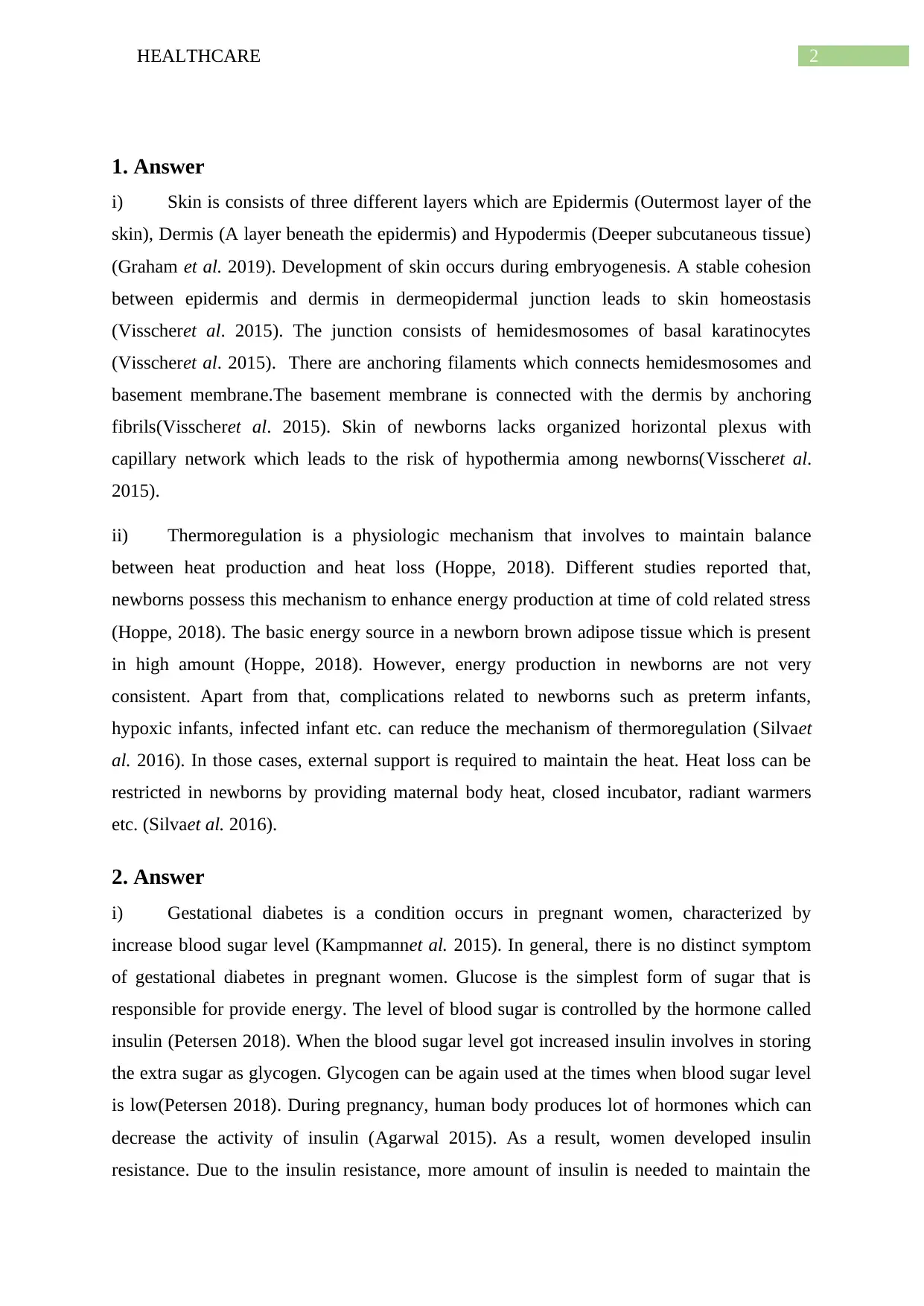
2HEALTHCARE
1. Answer
i) Skin is consists of three different layers which are Epidermis (Outermost layer of the
skin), Dermis (A layer beneath the epidermis) and Hypodermis (Deeper subcutaneous tissue)
(Graham et al. 2019). Development of skin occurs during embryogenesis. A stable cohesion
between epidermis and dermis in dermeopidermal junction leads to skin homeostasis
(Visscheret al. 2015). The junction consists of hemidesmosomes of basal karatinocytes
(Visscheret al. 2015). There are anchoring filaments which connects hemidesmosomes and
basement membrane.The basement membrane is connected with the dermis by anchoring
fibrils(Visscheret al. 2015). Skin of newborns lacks organized horizontal plexus with
capillary network which leads to the risk of hypothermia among newborns(Visscheret al.
2015).
ii) Thermoregulation is a physiologic mechanism that involves to maintain balance
between heat production and heat loss (Hoppe, 2018). Different studies reported that,
newborns possess this mechanism to enhance energy production at time of cold related stress
(Hoppe, 2018). The basic energy source in a newborn brown adipose tissue which is present
in high amount (Hoppe, 2018). However, energy production in newborns are not very
consistent. Apart from that, complications related to newborns such as preterm infants,
hypoxic infants, infected infant etc. can reduce the mechanism of thermoregulation (Silvaet
al. 2016). In those cases, external support is required to maintain the heat. Heat loss can be
restricted in newborns by providing maternal body heat, closed incubator, radiant warmers
etc. (Silvaet al. 2016).
2. Answer
i) Gestational diabetes is a condition occurs in pregnant women, characterized by
increase blood sugar level (Kampmannet al. 2015). In general, there is no distinct symptom
of gestational diabetes in pregnant women. Glucose is the simplest form of sugar that is
responsible for provide energy. The level of blood sugar is controlled by the hormone called
insulin (Petersen 2018). When the blood sugar level got increased insulin involves in storing
the extra sugar as glycogen. Glycogen can be again used at the times when blood sugar level
is low(Petersen 2018). During pregnancy, human body produces lot of hormones which can
decrease the activity of insulin (Agarwal 2015). As a result, women developed insulin
resistance. Due to the insulin resistance, more amount of insulin is needed to maintain the
1. Answer
i) Skin is consists of three different layers which are Epidermis (Outermost layer of the
skin), Dermis (A layer beneath the epidermis) and Hypodermis (Deeper subcutaneous tissue)
(Graham et al. 2019). Development of skin occurs during embryogenesis. A stable cohesion
between epidermis and dermis in dermeopidermal junction leads to skin homeostasis
(Visscheret al. 2015). The junction consists of hemidesmosomes of basal karatinocytes
(Visscheret al. 2015). There are anchoring filaments which connects hemidesmosomes and
basement membrane.The basement membrane is connected with the dermis by anchoring
fibrils(Visscheret al. 2015). Skin of newborns lacks organized horizontal plexus with
capillary network which leads to the risk of hypothermia among newborns(Visscheret al.
2015).
ii) Thermoregulation is a physiologic mechanism that involves to maintain balance
between heat production and heat loss (Hoppe, 2018). Different studies reported that,
newborns possess this mechanism to enhance energy production at time of cold related stress
(Hoppe, 2018). The basic energy source in a newborn brown adipose tissue which is present
in high amount (Hoppe, 2018). However, energy production in newborns are not very
consistent. Apart from that, complications related to newborns such as preterm infants,
hypoxic infants, infected infant etc. can reduce the mechanism of thermoregulation (Silvaet
al. 2016). In those cases, external support is required to maintain the heat. Heat loss can be
restricted in newborns by providing maternal body heat, closed incubator, radiant warmers
etc. (Silvaet al. 2016).
2. Answer
i) Gestational diabetes is a condition occurs in pregnant women, characterized by
increase blood sugar level (Kampmannet al. 2015). In general, there is no distinct symptom
of gestational diabetes in pregnant women. Glucose is the simplest form of sugar that is
responsible for provide energy. The level of blood sugar is controlled by the hormone called
insulin (Petersen 2018). When the blood sugar level got increased insulin involves in storing
the extra sugar as glycogen. Glycogen can be again used at the times when blood sugar level
is low(Petersen 2018). During pregnancy, human body produces lot of hormones which can
decrease the activity of insulin (Agarwal 2015). As a result, women developed insulin
resistance. Due to the insulin resistance, more amount of insulin is needed to maintain the
⊘ This is a preview!⊘
Do you want full access?
Subscribe today to unlock all pages.

Trusted by 1+ million students worldwide
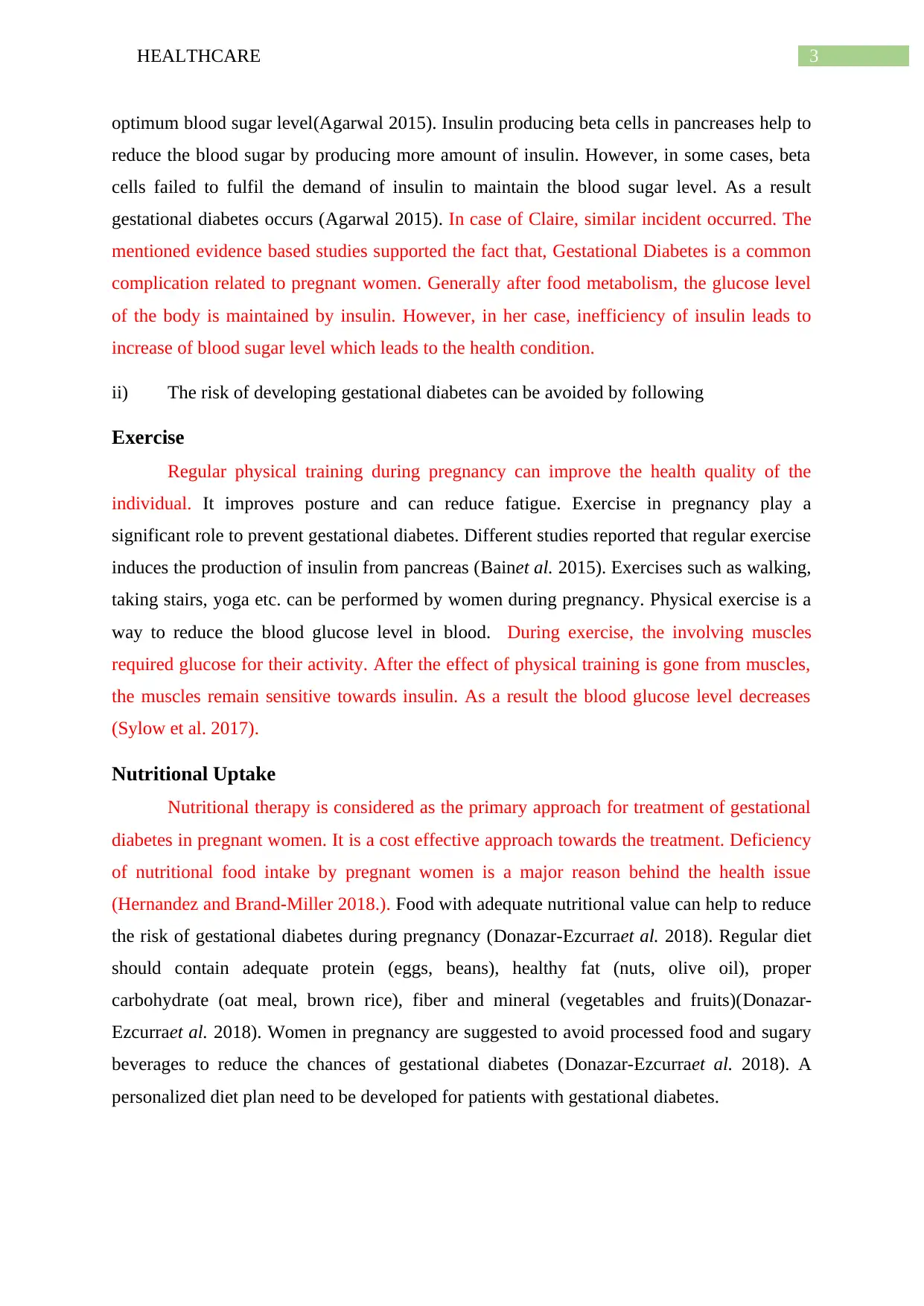
3HEALTHCARE
optimum blood sugar level(Agarwal 2015). Insulin producing beta cells in pancreases help to
reduce the blood sugar by producing more amount of insulin. However, in some cases, beta
cells failed to fulfil the demand of insulin to maintain the blood sugar level. As a result
gestational diabetes occurs (Agarwal 2015). In case of Claire, similar incident occurred. The
mentioned evidence based studies supported the fact that, Gestational Diabetes is a common
complication related to pregnant women. Generally after food metabolism, the glucose level
of the body is maintained by insulin. However, in her case, inefficiency of insulin leads to
increase of blood sugar level which leads to the health condition.
ii) The risk of developing gestational diabetes can be avoided by following
Exercise
Regular physical training during pregnancy can improve the health quality of the
individual. It improves posture and can reduce fatigue. Exercise in pregnancy play a
significant role to prevent gestational diabetes. Different studies reported that regular exercise
induces the production of insulin from pancreas (Bainet al. 2015). Exercises such as walking,
taking stairs, yoga etc. can be performed by women during pregnancy. Physical exercise is a
way to reduce the blood glucose level in blood. During exercise, the involving muscles
required glucose for their activity. After the effect of physical training is gone from muscles,
the muscles remain sensitive towards insulin. As a result the blood glucose level decreases
(Sylow et al. 2017).
Nutritional Uptake
Nutritional therapy is considered as the primary approach for treatment of gestational
diabetes in pregnant women. It is a cost effective approach towards the treatment. Deficiency
of nutritional food intake by pregnant women is a major reason behind the health issue
(Hernandez and Brand-Miller 2018.). Food with adequate nutritional value can help to reduce
the risk of gestational diabetes during pregnancy (Donazar-Ezcurraet al. 2018). Regular diet
should contain adequate protein (eggs, beans), healthy fat (nuts, olive oil), proper
carbohydrate (oat meal, brown rice), fiber and mineral (vegetables and fruits)(Donazar-
Ezcurraet al. 2018). Women in pregnancy are suggested to avoid processed food and sugary
beverages to reduce the chances of gestational diabetes (Donazar-Ezcurraet al. 2018). A
personalized diet plan need to be developed for patients with gestational diabetes.
optimum blood sugar level(Agarwal 2015). Insulin producing beta cells in pancreases help to
reduce the blood sugar by producing more amount of insulin. However, in some cases, beta
cells failed to fulfil the demand of insulin to maintain the blood sugar level. As a result
gestational diabetes occurs (Agarwal 2015). In case of Claire, similar incident occurred. The
mentioned evidence based studies supported the fact that, Gestational Diabetes is a common
complication related to pregnant women. Generally after food metabolism, the glucose level
of the body is maintained by insulin. However, in her case, inefficiency of insulin leads to
increase of blood sugar level which leads to the health condition.
ii) The risk of developing gestational diabetes can be avoided by following
Exercise
Regular physical training during pregnancy can improve the health quality of the
individual. It improves posture and can reduce fatigue. Exercise in pregnancy play a
significant role to prevent gestational diabetes. Different studies reported that regular exercise
induces the production of insulin from pancreas (Bainet al. 2015). Exercises such as walking,
taking stairs, yoga etc. can be performed by women during pregnancy. Physical exercise is a
way to reduce the blood glucose level in blood. During exercise, the involving muscles
required glucose for their activity. After the effect of physical training is gone from muscles,
the muscles remain sensitive towards insulin. As a result the blood glucose level decreases
(Sylow et al. 2017).
Nutritional Uptake
Nutritional therapy is considered as the primary approach for treatment of gestational
diabetes in pregnant women. It is a cost effective approach towards the treatment. Deficiency
of nutritional food intake by pregnant women is a major reason behind the health issue
(Hernandez and Brand-Miller 2018.). Food with adequate nutritional value can help to reduce
the risk of gestational diabetes during pregnancy (Donazar-Ezcurraet al. 2018). Regular diet
should contain adequate protein (eggs, beans), healthy fat (nuts, olive oil), proper
carbohydrate (oat meal, brown rice), fiber and mineral (vegetables and fruits)(Donazar-
Ezcurraet al. 2018). Women in pregnancy are suggested to avoid processed food and sugary
beverages to reduce the chances of gestational diabetes (Donazar-Ezcurraet al. 2018). A
personalized diet plan need to be developed for patients with gestational diabetes.
Paraphrase This Document
Need a fresh take? Get an instant paraphrase of this document with our AI Paraphraser
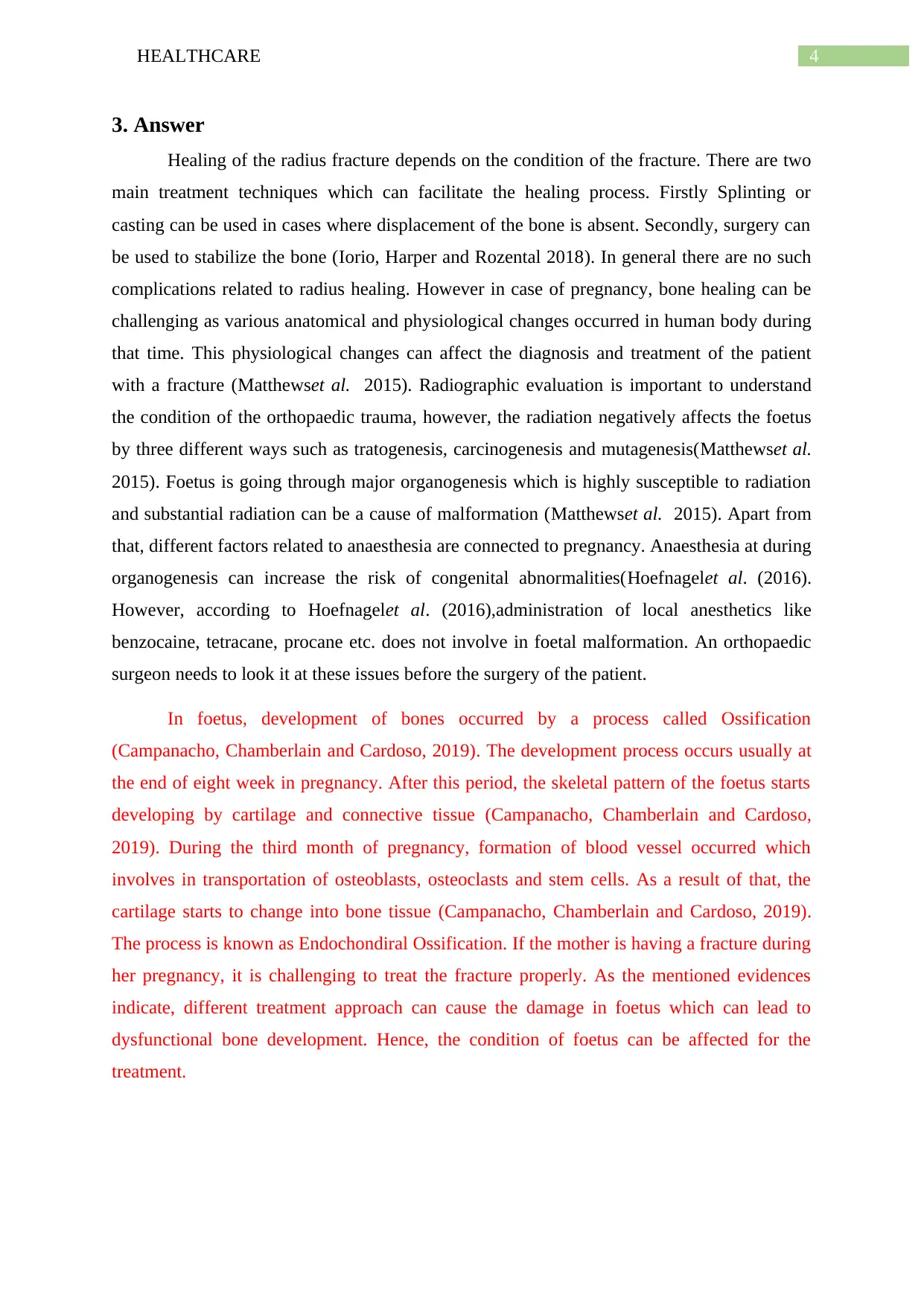
4HEALTHCARE
3. Answer
Healing of the radius fracture depends on the condition of the fracture. There are two
main treatment techniques which can facilitate the healing process. Firstly Splinting or
casting can be used in cases where displacement of the bone is absent. Secondly, surgery can
be used to stabilize the bone (Iorio, Harper and Rozental 2018). In general there are no such
complications related to radius healing. However in case of pregnancy, bone healing can be
challenging as various anatomical and physiological changes occurred in human body during
that time. This physiological changes can affect the diagnosis and treatment of the patient
with a fracture (Matthewset al. 2015). Radiographic evaluation is important to understand
the condition of the orthopaedic trauma, however, the radiation negatively affects the foetus
by three different ways such as tratogenesis, carcinogenesis and mutagenesis(Matthewset al.
2015). Foetus is going through major organogenesis which is highly susceptible to radiation
and substantial radiation can be a cause of malformation (Matthewset al. 2015). Apart from
that, different factors related to anaesthesia are connected to pregnancy. Anaesthesia at during
organogenesis can increase the risk of congenital abnormalities(Hoefnagelet al. (2016).
However, according to Hoefnagelet al. (2016),administration of local anesthetics like
benzocaine, tetracane, procane etc. does not involve in foetal malformation. An orthopaedic
surgeon needs to look it at these issues before the surgery of the patient.
In foetus, development of bones occurred by a process called Ossification
(Campanacho, Chamberlain and Cardoso, 2019). The development process occurs usually at
the end of eight week in pregnancy. After this period, the skeletal pattern of the foetus starts
developing by cartilage and connective tissue (Campanacho, Chamberlain and Cardoso,
2019). During the third month of pregnancy, formation of blood vessel occurred which
involves in transportation of osteoblasts, osteoclasts and stem cells. As a result of that, the
cartilage starts to change into bone tissue (Campanacho, Chamberlain and Cardoso, 2019).
The process is known as Endochondiral Ossification. If the mother is having a fracture during
her pregnancy, it is challenging to treat the fracture properly. As the mentioned evidences
indicate, different treatment approach can cause the damage in foetus which can lead to
dysfunctional bone development. Hence, the condition of foetus can be affected for the
treatment.
3. Answer
Healing of the radius fracture depends on the condition of the fracture. There are two
main treatment techniques which can facilitate the healing process. Firstly Splinting or
casting can be used in cases where displacement of the bone is absent. Secondly, surgery can
be used to stabilize the bone (Iorio, Harper and Rozental 2018). In general there are no such
complications related to radius healing. However in case of pregnancy, bone healing can be
challenging as various anatomical and physiological changes occurred in human body during
that time. This physiological changes can affect the diagnosis and treatment of the patient
with a fracture (Matthewset al. 2015). Radiographic evaluation is important to understand
the condition of the orthopaedic trauma, however, the radiation negatively affects the foetus
by three different ways such as tratogenesis, carcinogenesis and mutagenesis(Matthewset al.
2015). Foetus is going through major organogenesis which is highly susceptible to radiation
and substantial radiation can be a cause of malformation (Matthewset al. 2015). Apart from
that, different factors related to anaesthesia are connected to pregnancy. Anaesthesia at during
organogenesis can increase the risk of congenital abnormalities(Hoefnagelet al. (2016).
However, according to Hoefnagelet al. (2016),administration of local anesthetics like
benzocaine, tetracane, procane etc. does not involve in foetal malformation. An orthopaedic
surgeon needs to look it at these issues before the surgery of the patient.
In foetus, development of bones occurred by a process called Ossification
(Campanacho, Chamberlain and Cardoso, 2019). The development process occurs usually at
the end of eight week in pregnancy. After this period, the skeletal pattern of the foetus starts
developing by cartilage and connective tissue (Campanacho, Chamberlain and Cardoso,
2019). During the third month of pregnancy, formation of blood vessel occurred which
involves in transportation of osteoblasts, osteoclasts and stem cells. As a result of that, the
cartilage starts to change into bone tissue (Campanacho, Chamberlain and Cardoso, 2019).
The process is known as Endochondiral Ossification. If the mother is having a fracture during
her pregnancy, it is challenging to treat the fracture properly. As the mentioned evidences
indicate, different treatment approach can cause the damage in foetus which can lead to
dysfunctional bone development. Hence, the condition of foetus can be affected for the
treatment.

5HEALTHCARE
4. Answer
Hyperemesis gravidarum (HG) is a medical condition generally occurs during
pregnancy. The symptoms include severe vomiting, nausea, electrolyte disturbance and
weight loss (London et al. 2017). This complication can affect various aspects of woman’s
health such as kidney, homeostasis and electrolytes which can lead to fatal consequences.
Apart from that, these patients can face hyponatermia, low serum urea and hypokalaemia
(London et al. 2017). The diagnosis of hyperemesis gravidarum can be done by the
indications of several health complications such as urinary tract infection, thyrotoxicosis,
uremia etc (London et al. 2017). The treatment of this condition is mostly done by
consumption of adequate diet which contains electrolytes, vitamin B6 and Vitamin B1. Apart
from that several medications can be used to reduce the symptoms. Claire may face different
health issues related to HG. The two major health issues are following
Electrolyte imbalance
Electrolytes refers to chemicals which can divided in forms of ions in body fluids.
These ions can involve in transporting the electrical energy which is required for muscle
contraction or nerve impulses. Electrolyte imbalance is directly connected with HG.
Hyponatermia, which is characterized by reduced level of sodium in plasma, can be a
complication related to HG (Londonet al. 2017). The common symptoms of Hyponatremia
includes headache, nausea, lethargy, vomiting, anorexia etc. Severe hyponatremia leads to
personality changes, ataxia, muscle weakness, drowsiness etc. (Londonet al. 2017). However,
rapid electrolyte input can cause severe outcomes as it can lead to osmotic demyelination
syndrome. Imbalance in serum electrolyte can lead to severe hypokalemia (Londonet al.
2017). Potassium deficiency in pregnant women can increase the mortality. Moreover, sever
hypokalemia can cause rhabdomyolysis in case of patients with HG. Potassium level can be
increased slowly under adequate monitoring to avoid cardiac arrest(Londonet al. 2017).
Nutritional Deficiency
Women with HG may face a severe nutritional deficiency. In most of the cases, the
nutritional intake reduces below 50%. Most of the patient, with HG have deficiency of
riboflavin, pyridoxine, thiamine, retinol binding protein and retinoic acid. Hence, patients
with HG have higher chances of nutritional deficiency and adequate supplementary treatment
is required along with therapeutic treatment(Londonet al. 2017). Complications related to
Vitamin K deficiency can lead to neonatal haemorrhage. According to a study by Eby (2016)
4. Answer
Hyperemesis gravidarum (HG) is a medical condition generally occurs during
pregnancy. The symptoms include severe vomiting, nausea, electrolyte disturbance and
weight loss (London et al. 2017). This complication can affect various aspects of woman’s
health such as kidney, homeostasis and electrolytes which can lead to fatal consequences.
Apart from that, these patients can face hyponatermia, low serum urea and hypokalaemia
(London et al. 2017). The diagnosis of hyperemesis gravidarum can be done by the
indications of several health complications such as urinary tract infection, thyrotoxicosis,
uremia etc (London et al. 2017). The treatment of this condition is mostly done by
consumption of adequate diet which contains electrolytes, vitamin B6 and Vitamin B1. Apart
from that several medications can be used to reduce the symptoms. Claire may face different
health issues related to HG. The two major health issues are following
Electrolyte imbalance
Electrolytes refers to chemicals which can divided in forms of ions in body fluids.
These ions can involve in transporting the electrical energy which is required for muscle
contraction or nerve impulses. Electrolyte imbalance is directly connected with HG.
Hyponatermia, which is characterized by reduced level of sodium in plasma, can be a
complication related to HG (Londonet al. 2017). The common symptoms of Hyponatremia
includes headache, nausea, lethargy, vomiting, anorexia etc. Severe hyponatremia leads to
personality changes, ataxia, muscle weakness, drowsiness etc. (Londonet al. 2017). However,
rapid electrolyte input can cause severe outcomes as it can lead to osmotic demyelination
syndrome. Imbalance in serum electrolyte can lead to severe hypokalemia (Londonet al.
2017). Potassium deficiency in pregnant women can increase the mortality. Moreover, sever
hypokalemia can cause rhabdomyolysis in case of patients with HG. Potassium level can be
increased slowly under adequate monitoring to avoid cardiac arrest(Londonet al. 2017).
Nutritional Deficiency
Women with HG may face a severe nutritional deficiency. In most of the cases, the
nutritional intake reduces below 50%. Most of the patient, with HG have deficiency of
riboflavin, pyridoxine, thiamine, retinol binding protein and retinoic acid. Hence, patients
with HG have higher chances of nutritional deficiency and adequate supplementary treatment
is required along with therapeutic treatment(Londonet al. 2017). Complications related to
Vitamin K deficiency can lead to neonatal haemorrhage. According to a study by Eby (2016)
⊘ This is a preview!⊘
Do you want full access?
Subscribe today to unlock all pages.

Trusted by 1+ million students worldwide
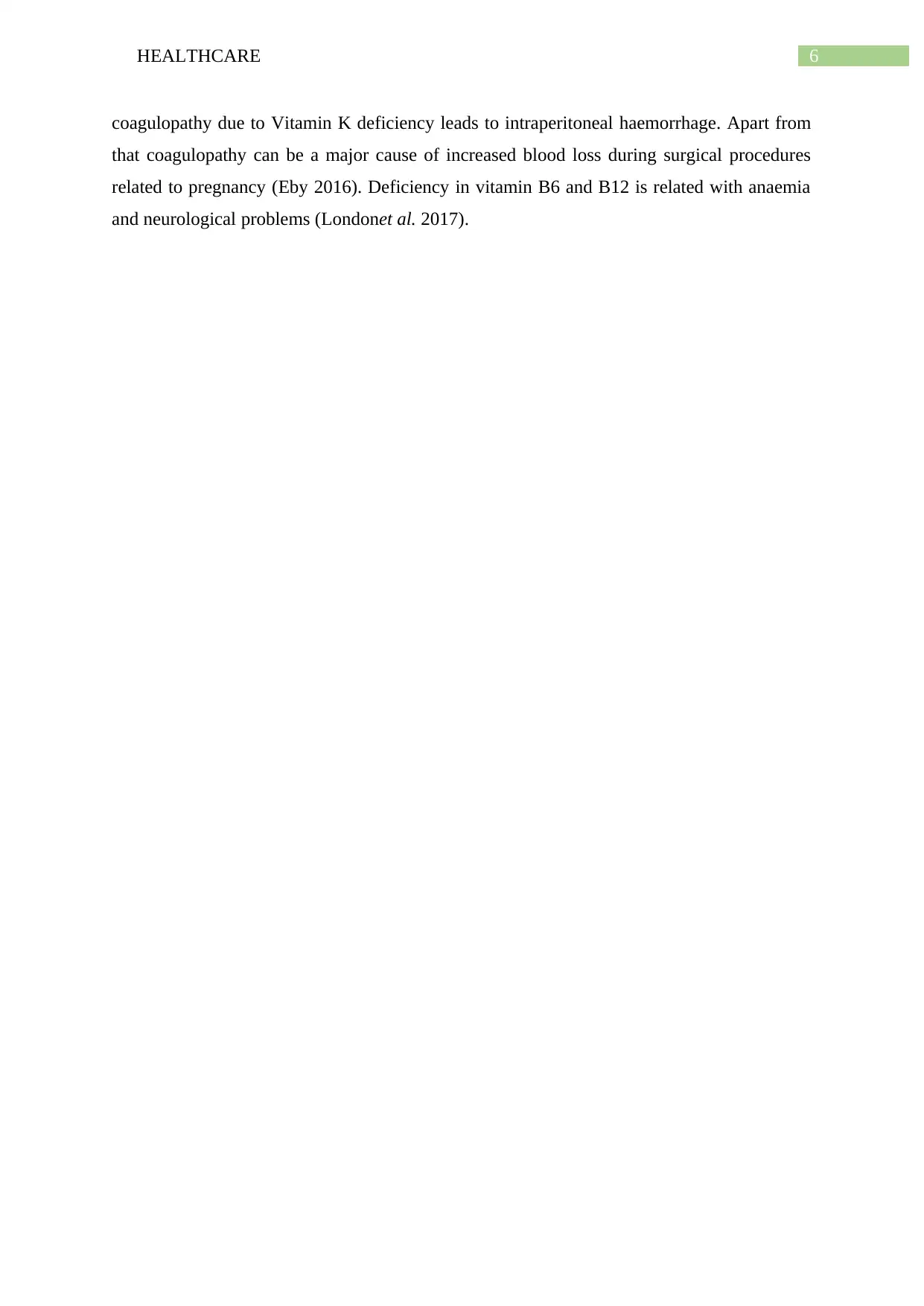
6HEALTHCARE
coagulopathy due to Vitamin K deficiency leads to intraperitoneal haemorrhage. Apart from
that coagulopathy can be a major cause of increased blood loss during surgical procedures
related to pregnancy (Eby 2016). Deficiency in vitamin B6 and B12 is related with anaemia
and neurological problems (Londonet al. 2017).
coagulopathy due to Vitamin K deficiency leads to intraperitoneal haemorrhage. Apart from
that coagulopathy can be a major cause of increased blood loss during surgical procedures
related to pregnancy (Eby 2016). Deficiency in vitamin B6 and B12 is related with anaemia
and neurological problems (Londonet al. 2017).
Paraphrase This Document
Need a fresh take? Get an instant paraphrase of this document with our AI Paraphraser
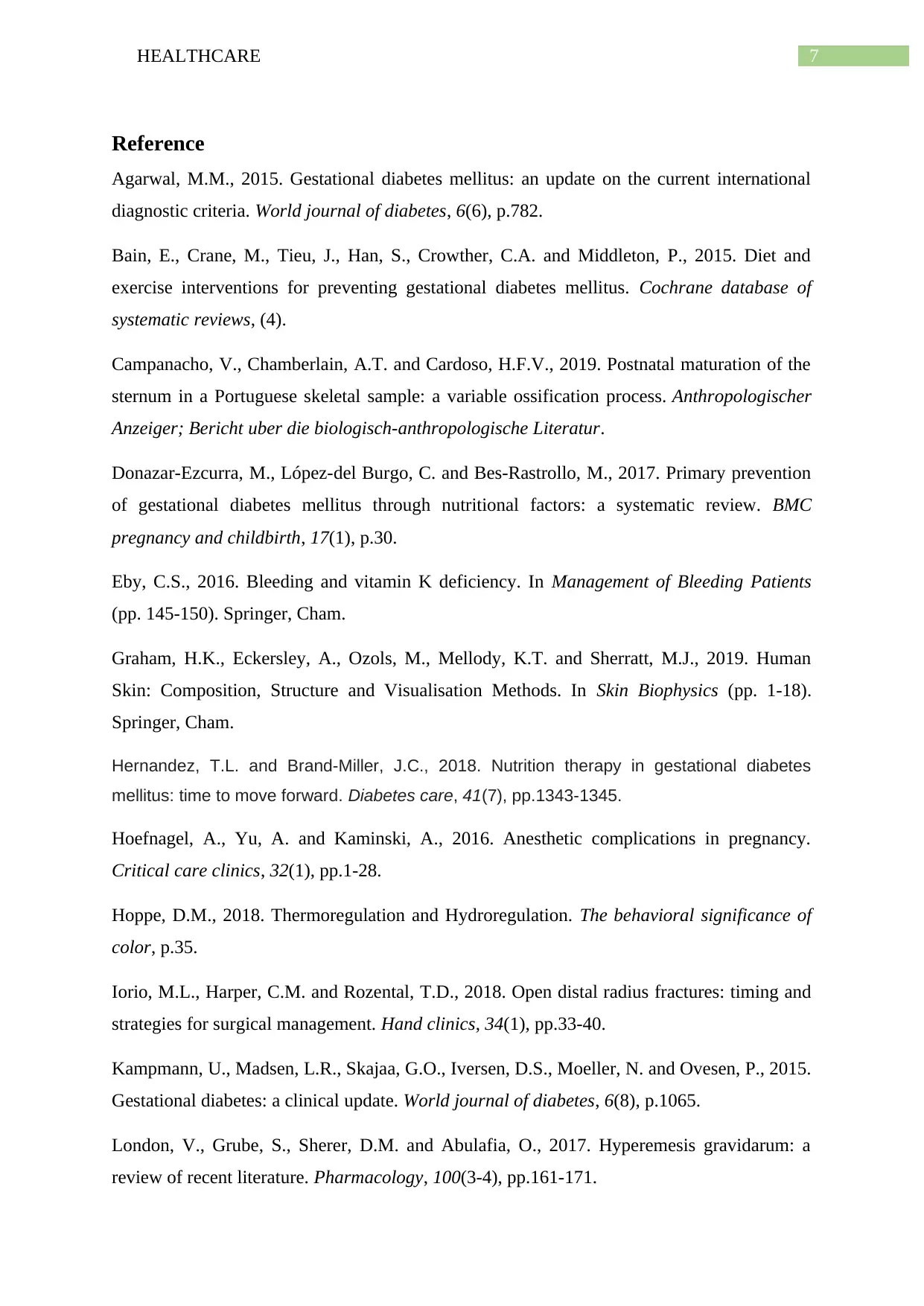
7HEALTHCARE
Reference
Agarwal, M.M., 2015. Gestational diabetes mellitus: an update on the current international
diagnostic criteria. World journal of diabetes, 6(6), p.782.
Bain, E., Crane, M., Tieu, J., Han, S., Crowther, C.A. and Middleton, P., 2015. Diet and
exercise interventions for preventing gestational diabetes mellitus. Cochrane database of
systematic reviews, (4).
Campanacho, V., Chamberlain, A.T. and Cardoso, H.F.V., 2019. Postnatal maturation of the
sternum in a Portuguese skeletal sample: a variable ossification process. Anthropologischer
Anzeiger; Bericht uber die biologisch-anthropologische Literatur.
Donazar-Ezcurra, M., López-del Burgo, C. and Bes-Rastrollo, M., 2017. Primary prevention
of gestational diabetes mellitus through nutritional factors: a systematic review. BMC
pregnancy and childbirth, 17(1), p.30.
Eby, C.S., 2016. Bleeding and vitamin K deficiency. In Management of Bleeding Patients
(pp. 145-150). Springer, Cham.
Graham, H.K., Eckersley, A., Ozols, M., Mellody, K.T. and Sherratt, M.J., 2019. Human
Skin: Composition, Structure and Visualisation Methods. In Skin Biophysics (pp. 1-18).
Springer, Cham.
Hernandez, T.L. and Brand-Miller, J.C., 2018. Nutrition therapy in gestational diabetes
mellitus: time to move forward. Diabetes care, 41(7), pp.1343-1345.
Hoefnagel, A., Yu, A. and Kaminski, A., 2016. Anesthetic complications in pregnancy.
Critical care clinics, 32(1), pp.1-28.
Hoppe, D.M., 2018. Thermoregulation and Hydroregulation. The behavioral significance of
color, p.35.
Iorio, M.L., Harper, C.M. and Rozental, T.D., 2018. Open distal radius fractures: timing and
strategies for surgical management. Hand clinics, 34(1), pp.33-40.
Kampmann, U., Madsen, L.R., Skajaa, G.O., Iversen, D.S., Moeller, N. and Ovesen, P., 2015.
Gestational diabetes: a clinical update. World journal of diabetes, 6(8), p.1065.
London, V., Grube, S., Sherer, D.M. and Abulafia, O., 2017. Hyperemesis gravidarum: a
review of recent literature. Pharmacology, 100(3-4), pp.161-171.
Reference
Agarwal, M.M., 2015. Gestational diabetes mellitus: an update on the current international
diagnostic criteria. World journal of diabetes, 6(6), p.782.
Bain, E., Crane, M., Tieu, J., Han, S., Crowther, C.A. and Middleton, P., 2015. Diet and
exercise interventions for preventing gestational diabetes mellitus. Cochrane database of
systematic reviews, (4).
Campanacho, V., Chamberlain, A.T. and Cardoso, H.F.V., 2019. Postnatal maturation of the
sternum in a Portuguese skeletal sample: a variable ossification process. Anthropologischer
Anzeiger; Bericht uber die biologisch-anthropologische Literatur.
Donazar-Ezcurra, M., López-del Burgo, C. and Bes-Rastrollo, M., 2017. Primary prevention
of gestational diabetes mellitus through nutritional factors: a systematic review. BMC
pregnancy and childbirth, 17(1), p.30.
Eby, C.S., 2016. Bleeding and vitamin K deficiency. In Management of Bleeding Patients
(pp. 145-150). Springer, Cham.
Graham, H.K., Eckersley, A., Ozols, M., Mellody, K.T. and Sherratt, M.J., 2019. Human
Skin: Composition, Structure and Visualisation Methods. In Skin Biophysics (pp. 1-18).
Springer, Cham.
Hernandez, T.L. and Brand-Miller, J.C., 2018. Nutrition therapy in gestational diabetes
mellitus: time to move forward. Diabetes care, 41(7), pp.1343-1345.
Hoefnagel, A., Yu, A. and Kaminski, A., 2016. Anesthetic complications in pregnancy.
Critical care clinics, 32(1), pp.1-28.
Hoppe, D.M., 2018. Thermoregulation and Hydroregulation. The behavioral significance of
color, p.35.
Iorio, M.L., Harper, C.M. and Rozental, T.D., 2018. Open distal radius fractures: timing and
strategies for surgical management. Hand clinics, 34(1), pp.33-40.
Kampmann, U., Madsen, L.R., Skajaa, G.O., Iversen, D.S., Moeller, N. and Ovesen, P., 2015.
Gestational diabetes: a clinical update. World journal of diabetes, 6(8), p.1065.
London, V., Grube, S., Sherer, D.M. and Abulafia, O., 2017. Hyperemesis gravidarum: a
review of recent literature. Pharmacology, 100(3-4), pp.161-171.
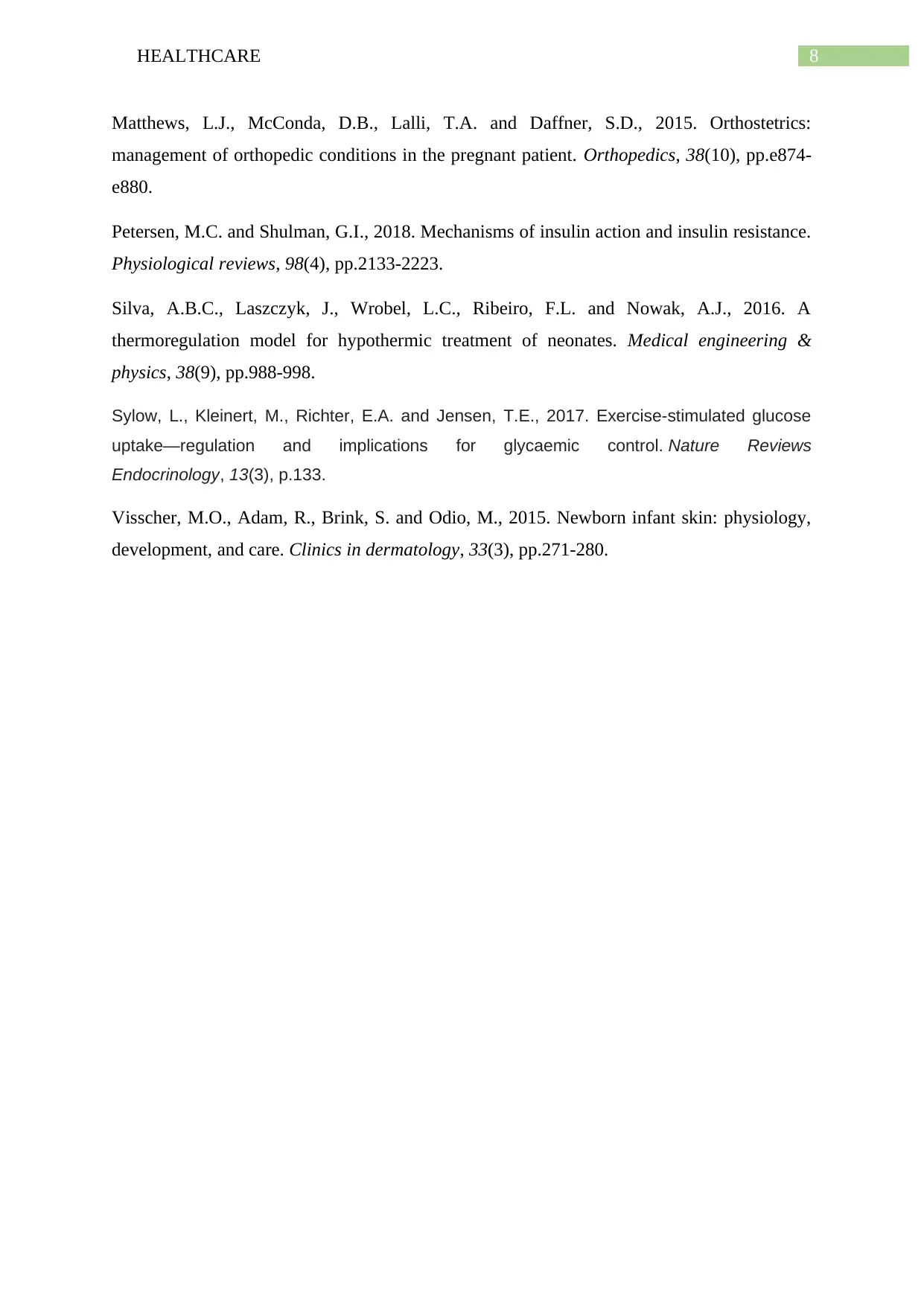
8HEALTHCARE
Matthews, L.J., McConda, D.B., Lalli, T.A. and Daffner, S.D., 2015. Orthostetrics:
management of orthopedic conditions in the pregnant patient. Orthopedics, 38(10), pp.e874-
e880.
Petersen, M.C. and Shulman, G.I., 2018. Mechanisms of insulin action and insulin resistance.
Physiological reviews, 98(4), pp.2133-2223.
Silva, A.B.C., Laszczyk, J., Wrobel, L.C., Ribeiro, F.L. and Nowak, A.J., 2016. A
thermoregulation model for hypothermic treatment of neonates. Medical engineering &
physics, 38(9), pp.988-998.
Sylow, L., Kleinert, M., Richter, E.A. and Jensen, T.E., 2017. Exercise-stimulated glucose
uptake—regulation and implications for glycaemic control. Nature Reviews
Endocrinology, 13(3), p.133.
Visscher, M.O., Adam, R., Brink, S. and Odio, M., 2015. Newborn infant skin: physiology,
development, and care. Clinics in dermatology, 33(3), pp.271-280.
Matthews, L.J., McConda, D.B., Lalli, T.A. and Daffner, S.D., 2015. Orthostetrics:
management of orthopedic conditions in the pregnant patient. Orthopedics, 38(10), pp.e874-
e880.
Petersen, M.C. and Shulman, G.I., 2018. Mechanisms of insulin action and insulin resistance.
Physiological reviews, 98(4), pp.2133-2223.
Silva, A.B.C., Laszczyk, J., Wrobel, L.C., Ribeiro, F.L. and Nowak, A.J., 2016. A
thermoregulation model for hypothermic treatment of neonates. Medical engineering &
physics, 38(9), pp.988-998.
Sylow, L., Kleinert, M., Richter, E.A. and Jensen, T.E., 2017. Exercise-stimulated glucose
uptake—regulation and implications for glycaemic control. Nature Reviews
Endocrinology, 13(3), p.133.
Visscher, M.O., Adam, R., Brink, S. and Odio, M., 2015. Newborn infant skin: physiology,
development, and care. Clinics in dermatology, 33(3), pp.271-280.
⊘ This is a preview!⊘
Do you want full access?
Subscribe today to unlock all pages.

Trusted by 1+ million students worldwide
1 out of 9
Your All-in-One AI-Powered Toolkit for Academic Success.
+13062052269
info@desklib.com
Available 24*7 on WhatsApp / Email
![[object Object]](/_next/static/media/star-bottom.7253800d.svg)
Unlock your academic potential
Copyright © 2020–2025 A2Z Services. All Rights Reserved. Developed and managed by ZUCOL.

